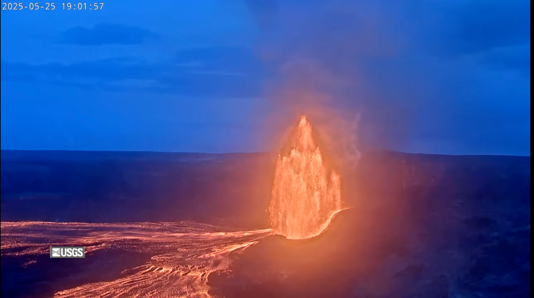Hawaii’s restless Kilauea volcano has erupted once again, launching lava more than 1,000 feet into the sky and blanketing the air with volcanic ash in a breathtaking but hazardous display.
The U.S. Geological Survey (USGS) reported that the eruption began at around 4:15 p.m. on Sunday, May 25, and lasted several hours, marking another fiery chapter in the volcano’s frequent bursts of activity since December 2024.
According to the Hawaiian Volcano Observatory, lava gushed from the north vent of Kilauea’s summit caldera, with fountains reaching over 1,000 feet before subsiding just before 10 p.m.
The south vent continued spewing lava up to 800 feet in height until around 10:25 p.m.
Thankfully, all lava flows remained contained within the volcano’s summit crater, posing no immediate threat to nearby communities.
However, the eruption generated an ash plume that soared to at least 5,000 feet, carrying fine particles of ash, volcanic rock, and razor-sharp Pele’s hair—thin strands of volcanic glass that pose health hazards when carried by the wind. The USGS has urged locals and tourists to take precautions.
Kilauea, situated in Hawaii Volcanoes National Park on the Big Island, about 200 miles from Honolulu, is one of the most active volcanoes on Earth.
The latest eruption adds to a string of short-lived but powerful outbursts that have drawn global attention and increasing numbers of tourists.
With multiple USGS livestreams capturing the event in real time, the volcano continues to mesmerize the world—reminding us all of nature’s beauty and unpredictability.
Hawaii is also home to Mauna Loa, the world’s largest active volcano, which last erupted in 2022 and remains under close watch.



















